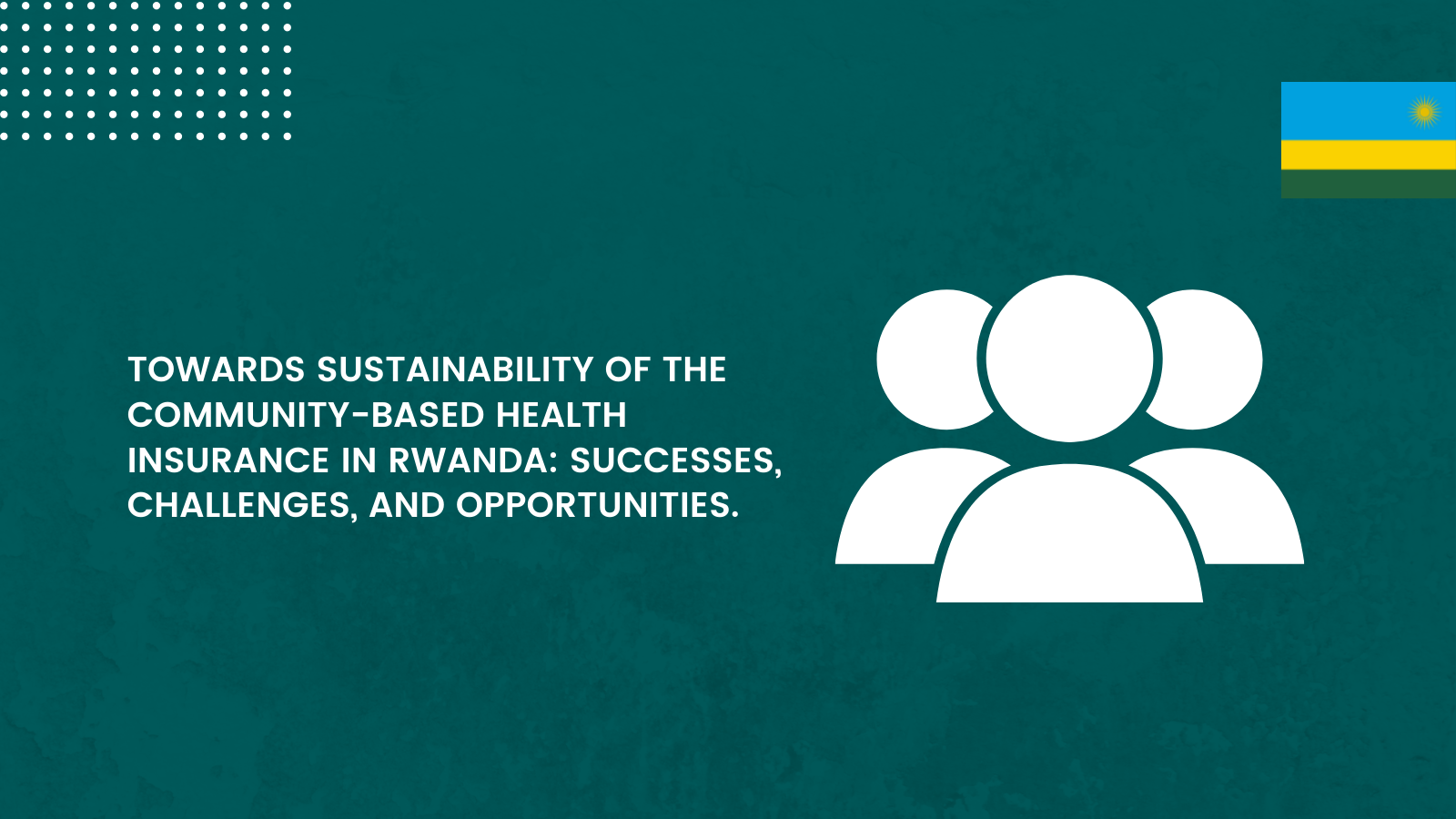Rwanda has made impressive gains in health over the last two decades. Life expectancy at birth has increased from 49 years in 2000 to 69.06 years in 2020 (National Institute of Statistics of Rwanda et al., 2020). The primary health care utilization rate increased from 0.81 visits per inhabitant in 2009 to 1.6 visits per inhabitant in 2019 (HMIS). These attainments were made possible through improvements in health care delivery and implementing several policy initiatives, including a nationwide Community-Based Health Insurance Scheme (CBHI). CBHI started in 1999 as a pilot project in 3 districts in response to the reintroduction of user fees. The success of these pilot schemes led progressively to the initiation of several schemes in the country, the development of a CBHI policy, and the national roll-out of CBHI in 2004.
Since its inception, the CBHI scheme has gone through several policy revisions, including the payment of contributions based on the household’s capacity to pay, the patient roaming system, and the transfer of the scheme to the Rwanda Social Security Board (RSSB). These revisions aimed to improve equity in financing, access to care and strengthen the management of the scheme.
The CBHI is currently the largest health insurance scheme in the country, with an estimated coverage rate of 85.6 per cent of the target population as of April 2021. Despite the extensive coverage, the capacity of CBHI to mobilize sufficient funds to cover its beneficiaries’ needs is continuously decreasing. In the recent past, total CBHI expenditures have been increasing, further raising the scheme’s financial sustainability issues. Total CBHI expenditures almost doubled between 2011-2012 and 2015-2016, rising from RWF 18.5 billion to 33.6 billion and reached RWF 48 billion in 2017-2018. The scheme has been consistently in deficit since 2011, and that deficit grew to reach RW F 14.3 billion in 2018-2019. In addition to the difference between revenues and expenditures, factors such as the lengthy paper-based management of claims, the steady rise of non-communicable diseases resulting in a higher need for services, the limited strategic purchasing capacity, and the provider payment mechanism in place pose important challenges to the sustainability of the scheme.
Though the scheme is facing many challenges, several opportunities to improve exist. First and foremost, there is a strong political commitment to ensure that all Rwandans have equitable access to health services of high quality, affordable, and without financial hardship. As the primary challenge of the CBHI is expenditures exceeding revenues and leading to consistent deficits over the years, the Government of Rwanda (GOR) introduced new domestic sources of revenues in September 2020 (Official gazette n° 105/03 of 30/09/2020). In addition to the existing cross-subsidization by other insurance schemes that remit ten percent (10%) of their revenue to CBHI, GOR added the following sources of revenue:
- Six billion Rwandan francs (FRW 6,000,000,000) as State annual budget allocation paid by the Ministry of Finance and Economic Planning (MINECOFIN);
- Three thousand Rwandan francs (FRW 3,000) for each person in category E of Ubudehe1 from State annual budget paid by the Ministry of Finance and Economic Planning;
- Fifty per cent (50%) of registration fees for pharmaceutical products, medical devices and food products paid by the public organ in charge of regulation of food and drugs in Rwanda;
- Fifty per cent (50%) of the amount collected by the National Ethics Committee on the research on human beings as research review fees, paid by the Ministry in charge of health;
- Ten per cent (10%) of fees charged on services offered to gaming companies paid by the Ministry in charge of trade
- Fifty per cent (50%) of fees collected for motor vehicle mechanical inspection paid by Rwanda National Police;
- Ten per cent (10%) of fees collected from road traffic fines paid by Rwanda National Police;
- Hundred per cent (100%) of the amount collected as penalties for the trade of substandard products paid by the Ministry in charge of finance;
- One hundred Rwandan francs (FRW 100) from parking fee levied on a vehicle for each hour of parking in the city of Kigali, paid by the City of Kigali;
- One per cent (1%) of tourism revenues paid by the national organ in charge of tourism, after-tax deduction, ten per cent (10%) allocated to the population surrounding national parks and five per cent (5%) allocated to the Special Guarantee Fund;
- Twenty thousand Rwandan francs (FRW 20,000) levied for transfer of ownership on a vehicle, and ten thousand Rwandan francs (FRW 10,000) levied for transfer of ownership on a motorcycle, paid by the public organ in charge of the collection of revenues in Rwanda;
- Five thousand Rwandan francs (FRW 5,000) for each hectare of a lease for hillside land of State reserved for agricultural and livestock, paid by the organ that leased the land;
- Four thousand Rwandan Francs (FRW 4,000) for each hectare of lease of non-protected marshland, paid by the organ that leased the marshland.
However, these efforts to mobilize more resources may not be sufficient without a thorough review of the functioning of the scheme. Significant changes are essential to make gains in efficiency, hence the commissioning of the CBHI sustainability plan by the GOR. Recommendations from this sustainability plan included a review of the provider payment mechanism, fee-for-service, currently implemented in the country at all point of care levels. More specifically, the GOR is exploring new ways of paying for health services to improve efficiency while delivering high-quality health services. Alternative payment approaches, such as capitation at the primary health care level, are being assessed for their ability to deliver quality health care at a lower cost and administrative burden. Secondly, the recent introduction of the Health Technology Assessment (HTA) to help guide the prioritization of health services presents an opportunity to make the best use of resources by ensuring that population needs, country’s priorities, and cost-effectiveness of interventions are considered. Thirdly, linking the existing quality improvement programs (accreditation and performance-based financing) with provider payments will emphasise the quality of health care services and strengthen strategic purchasing.
CBHI is one of the key pillars of health financing, and its continued success is vital to the future of the health service delivery system in Rwanda. The recommendations of the CBHI sustainability plan should provide a strategic roadmap to achieving and sustaining the scheme’s financial viability.
List of references
- The Republic of Rwanda, National Institute of Statistics, “Rwanda Statistical Yearbook 2018,” Kigali, Rwanda, 2018.
- Ministry of Health. Health Management and Information System (HMIS); Routine data, 2019.
- Prime Minister’s Order N° 105/03 Of 30/09/2020 Related to The Community-Based Health Insurance Scheme Contributions accessed at https://gazettes.africa/archive/rw/2020/rw-government-gazette-dated-2020-10-01-no-Special.pdf
- Rwanda Social Security Board, “Community Based Health Insurance Annual Report, Fiscal Year 2017-18.” Kigali – Rwanda, 2018.
- Rwanda Social Security Board, “Community Based Health Insurance Annual Report, Fiscal Year 2017-18.” 2018.
- Rwanda Social Security Board, “Community-Based Health Insurance Annual Report, Fiscal Year 2015-2016,” 2016.
AUTHORS

Alypio Nyandwi is a public health professional with experience in public policy analysis, planning, research, monitoring and evaluation. Alypio has over 15 years of working experience in Rwanda’s health sector, where he has worked with both governments and non-governmental organisations at the international level.

Stella Umuhoza is a lecturer and researcher at the University of Rwanda School of Public Health (UR/SPH) in the Department of Health Policy, Economics and Management. She has over ten years of experience working in public health systems. Currently, she serves as a member of the Community-Based Health Insurance (CBHI) Consultative Group and Health Financing Core Group in Rwanda. Stella recently developed Rwanda’s Health Financing Strategic Plan for 2018-2020 and the Family Planning (FP) investment case. Over the years, she has provided technical assistance to various government institutions and international organizations in developing policy documents and briefing notes to inform decision-making.

Dr Parfait Uwaliraye is the Director-General for Planning, Monitoring and Evaluation and Health Financing at the Ministry of Health in Rwanda, a position he has held since November 2012. Dr Uwaliraye is a medical doctor with a Master’s degree in Public Health. He worked as a Research Assistant, a District Medical Officer and the director of Kibagabaga District Hospital prior to joining the Ministry of Health. He has a particular focus on health policy, planning, health financing, private sector engagement and global health.

Sabine Musange F. is a lecturer and currently head of the Health Policy, Economics and Management department at the School of Public Health, University of Rwanda. With a background in both medicine and global health research, her research interests focus on strengthening health systems in low-resource settings. Previous work includes program evaluation in maternal and child health, health systems and financing. Most of her work has been carried out in low-income settings and she is passionate about women and child’s health and above all about improving population health.


Good summary. CBHI should also be accompanied by strengthening of primary health care and prevention services, especially for communicable and NCDs, as these are the largest consumers of health care budgets.